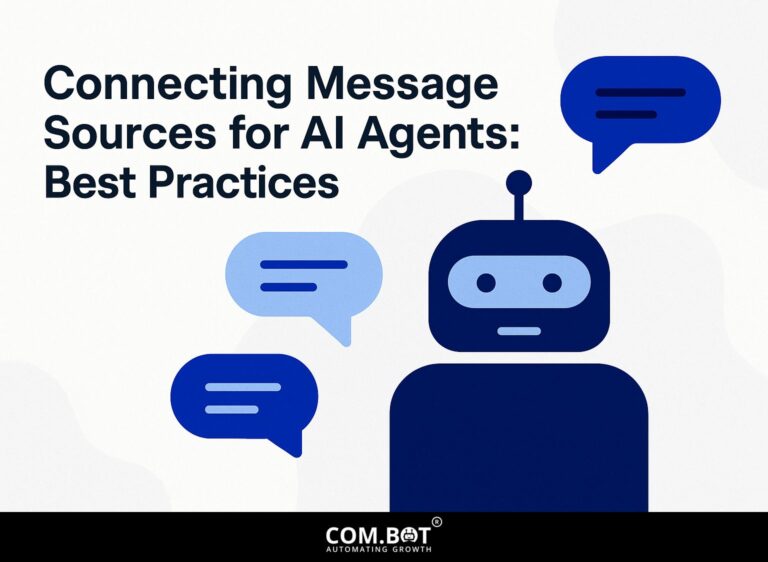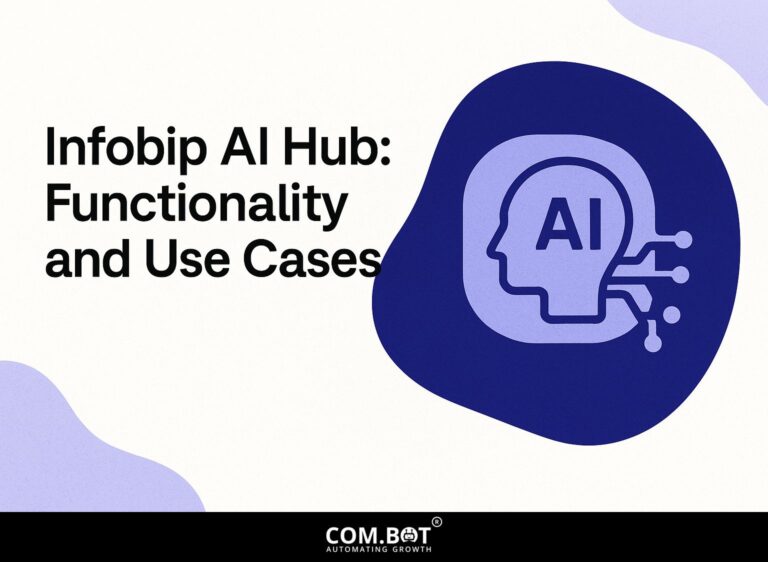Integrating Biometric Authentication with Chatbots: Best Practices
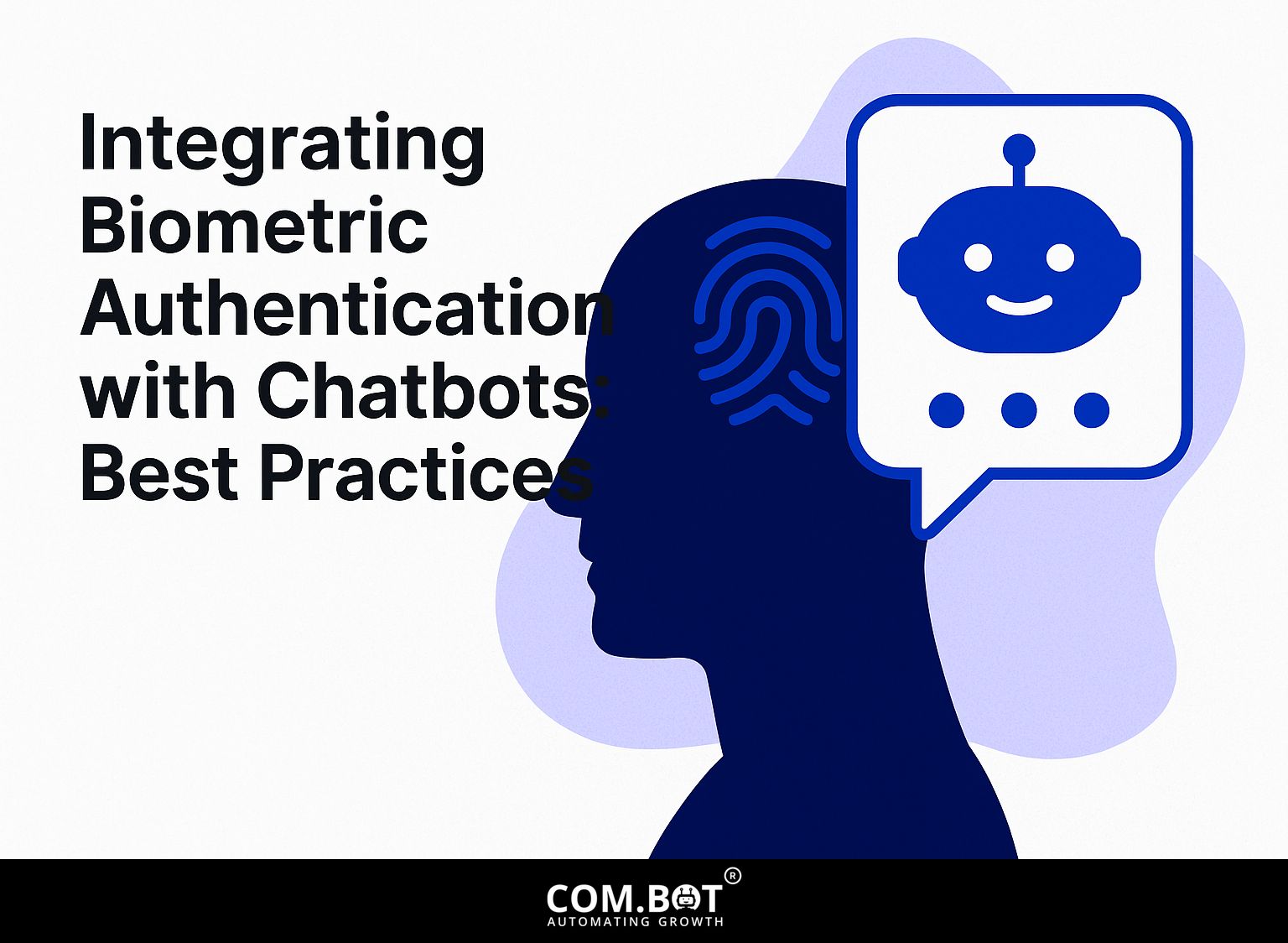
Combining fingerprint or face recognition with chatbots is changing how customers get help and making systems more secure. With the increase in artificial intelligence and the demand for trustworthy remote customer service because of COVID-19, chatbots are changing. This article looks at the best ways to add biometric technology to chatbots to provide a safe and smooth user experience. Learn how these new ideas can improve your customer interactions while keeping sensitive information safe.
Key Takeaways:
- Combining biometric login with chatbots gives better security and a smoother user experience.
- Choosing the right biometric technology and ensuring data security and compliance are key factors for successful implementation.
- As chatbots become more popular, using biometric authentication is increasingly important for improving user identification and data security.
- 1 Benefits of Biometric Authentication in Chatbots
- 2 Challenges in Integration
- 3 Best Practices for Implementing Biometric Authentication
- 4 Case Studies
- 5 Biometric Authentication and Chatbot Statistics in Banking (2025)
- 6 Upcoming Developments in Biometric Security and Chatbots
- 7 Frequently Asked Questions
- 7.1 1. What is the importance of integrating biometric authentication with chatbots?
- 7.2 2. What are the best practices for integrating biometric authentication with chatbots?
- 7.3 3. How can biometric authentication improve the efficiency of chatbots?
- 7.4 4. Is biometric authentication secure for chatbots?
- 7.5 5. What are the potential challenges of integrating biometric authentication with chatbots?
- 7.6 6. How can businesses benefit from integrating biometric authentication with chatbots?
1. Definition and Importance
Biometric authentication automatically checks a person’s identity using physical or behavioral characteristics and is key to safeguarding important data. This technology improves security by connecting access to unique personal features, like fingerprints or facial recognition, which are hard to copy.
For instance, 75% of organizations report increased user trust with biometric methods, citing higher engagement levels and reduced fraud.
Examples of basic biometric security are Apple’s Face ID or the fingerprint scanners found in smartphones. These technologies represent fundamental enhancements to traditional security systems.
By bringing these systems together, organizations protect sensitive information and make it easier for users to access what they need, ensuring security is strong and works smoothly. For an extensive analysis of this trend, our comprehensive study of internal knowledge base bots examines their role in bolstering security protocols.
2. Types of Biometric Data
Common types of biometric data include fingerprints, facial recognition, and voice patterns, each offering unique advantages and challenges in implementation.
Fingerprint recognition, such as Apple’s Touch ID, provides quick access to devices and strong security but can struggle with dirty or worn fingers.
Facial recognition, used in Facebook’s photo tagging, is effective for identifying users but may raise privacy concerns. Voice recognition tools, such as Google Assistant, allow hands-free interaction, making tasks simpler. However, they might struggle to identify accents or hear sounds in loud environments.
Each technology is most effective for specific tasks such as secure login, personalized ads, or customer support, depending on the context and users.
Benefits of Biometric Authentication in Chatbots
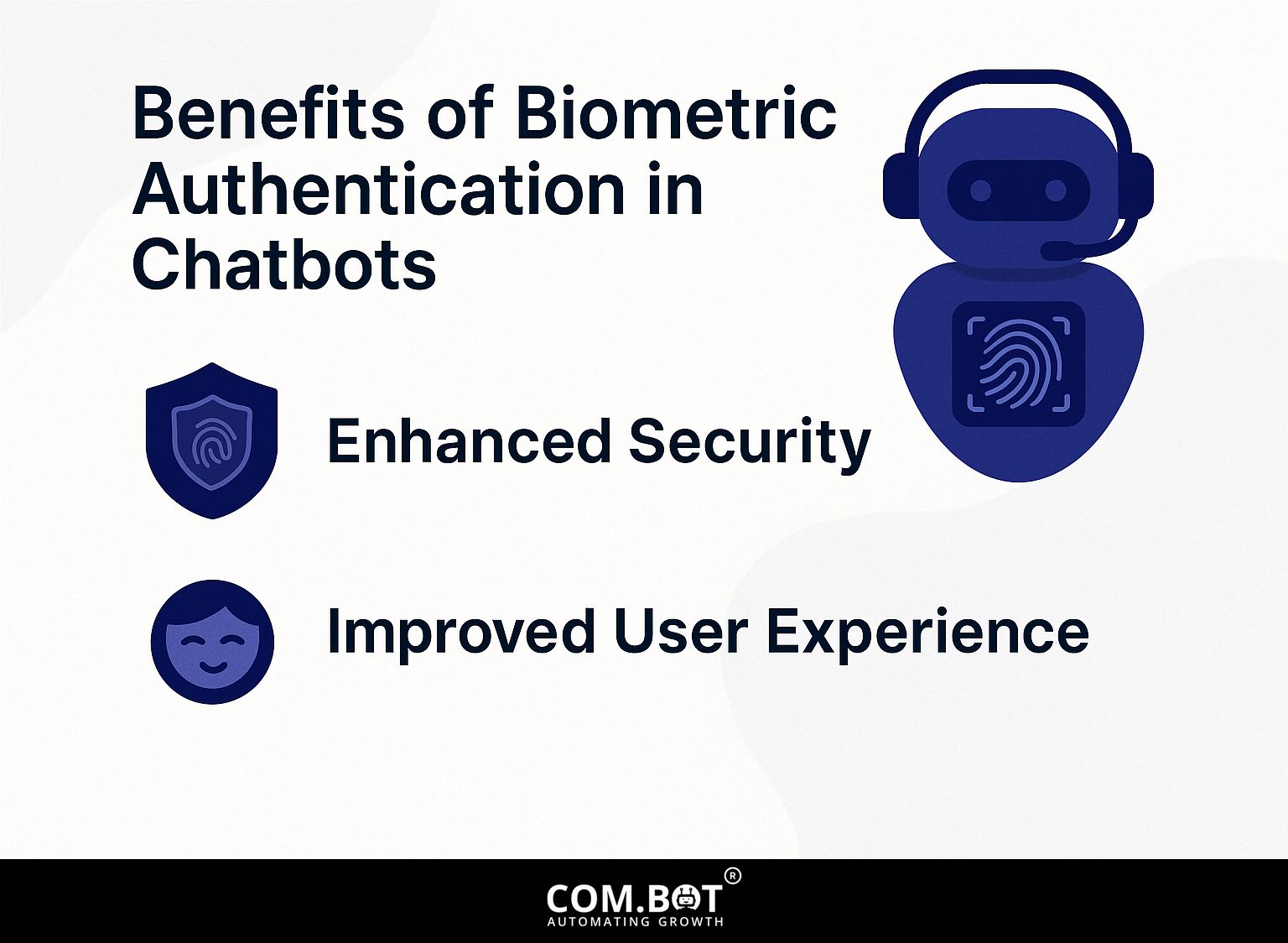
Adding biometric checks to chatbots can greatly improve security and how users interact, providing an easy way for them to engage. This technology is particularly relevant when looking at secured chatbots, which are designed with advanced features to enhance user experience and data protection.
1. Enhanced Security
Biometric authentication can lower the chance of data breaches by offering a strong way to check identity that is hard to fake or steal.
For example, companies like Salesforce employ biometric systems, such as fingerprint or facial recognition, for secure transactions. These systems are user-friendly and effective. Statistics show that biometric authentication can cut fraud by 99.9%.
Implementing such a system typically involves using software like Veridium or BioID, which can easily work together with existing chatbots. By using biometric solutions, companies can make data security better and increase users’ confidence in online transactions.
2. Improved User Experience
By using biometric information, chatbots can simplify customer verification, leading to better user experience and easier transactions. This method speeds up communication and improves safety.
An online retail giant saw a 30% increase in conversion rates after adding fingerprint and facial recognition technologies. Customers can quickly confirm who they are, allowing them to go from asking questions to buying with little waiting.
Implementing biometric authentication tools like Amazon Cognito or Apple’s Face ID can facilitate this integration. The reduced need for passwords means lower cart abandonment rates, demonstrating how technology can improve both efficiency and customer satisfaction.
Challenges in Integration
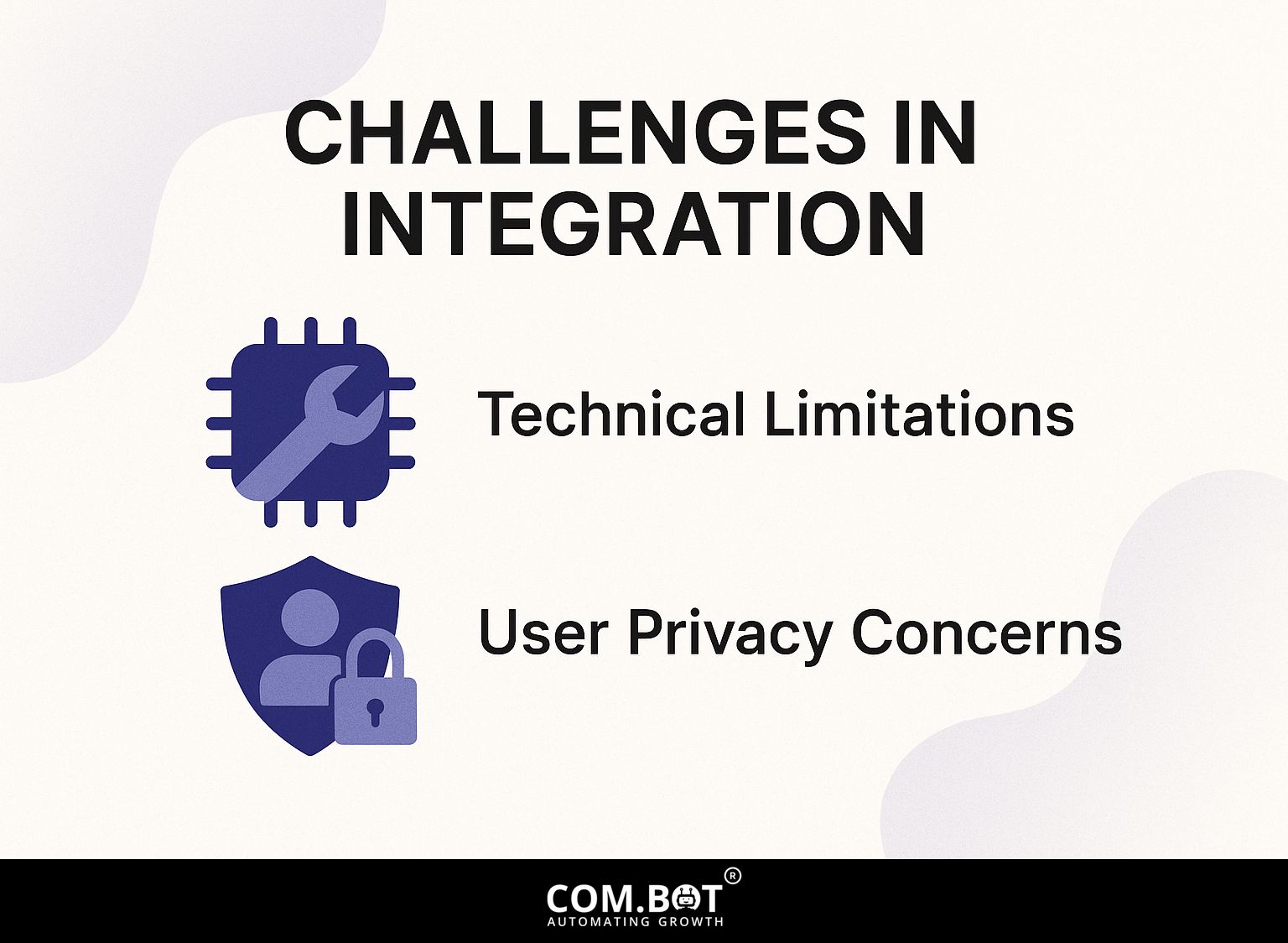
Even though it has benefits, combining biometric authentication with chatbots brings some difficulties that organizations need to handle wisely.
1. Technical Limitations
Technical limitations, such as the need for reliable APIs and processing power, can hinder the successful integration of biometric authentication in chatbots.
To solve these issues, focus on using reliable APIs like Microsoft’s Azure Face API, which provides detailed SDKs for easy connection.
Make sure your system has enough processing power by using cloud services like AWS Lambda, which can grow and manage large amounts of traffic well.
Think about setting up a backup system that switches to regular login methods if biometric systems don’t work. This approach improves user experience and provides security and dependability in your chatbot interactions.
2. User Privacy Concerns
User privacy concerns are paramount when implementing biometric authentication, as users may fear data misuse or breaches.
To address these fears, organizations must prioritize user education about how biometric data will be used, stored, and protected. It is important to get clear consent before collecting data. This can be achieved with simple and easy-to-read privacy policies and notifications for users.
Compliance with regulations like GDPR requires transparency and the option for users to withdraw consent anytime.
Tools such as VeraCrypt for data encryption and AWS for secure storage can safeguard sensitive information. Frequent interaction with users and sharing information about security steps helps build trust in the system.
Best Practices for Implementing Biometric Authentication
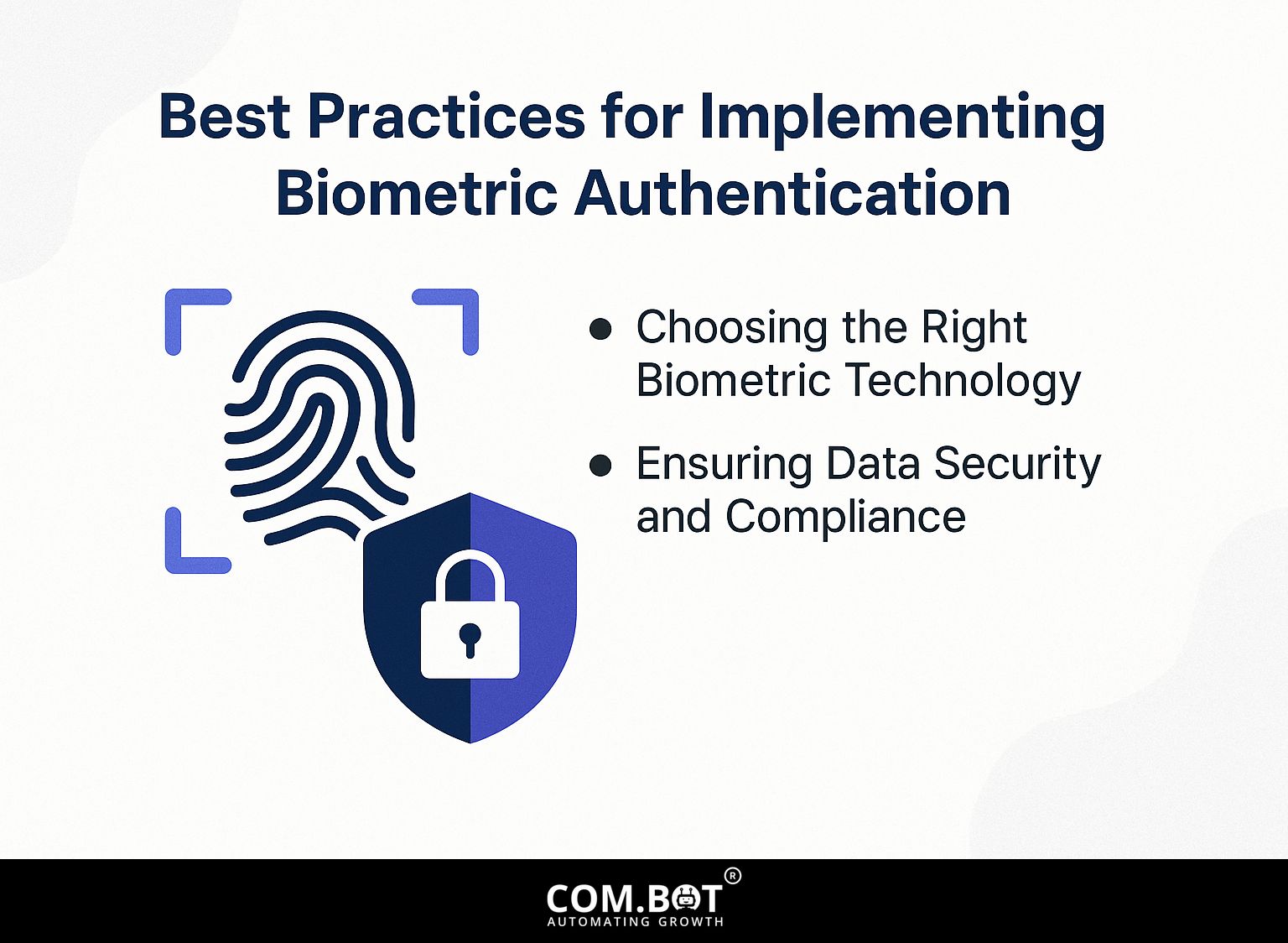
To effectively combine biometric authentication with chatbots, organizations should follow recommended methods that guarantee safety and user happiness. This approach aligns with the principles outlined in our analysis of Secured Chatbots: Features and Use Cases.
1. Choosing the Right Biometric Technology
Selecting the appropriate biometric technology-such as fingerprint, facial recognition, or voice authentication-depends on the specific needs and context of the application.
Fingerprint recognition, using tools like FingerprintJS, is accurate and affordable, making it perfect for secure device access. On the other hand, facial recognition, with solutions like BioID, provides a user-friendly interface and can be integrated into various systems, though it may incur higher implementation costs.
Voice authentication, while less common, is gaining traction for applications in customer service due to its hands-free convenience. Evaluate each option based on your budget, required accuracy, and ease of use to determine the best fit.
2. Ensuring Data Security and Compliance
Maintaining data security and compliance is essential when dealing with sensitive biometric data to prevent leaks and unauthorized access.
To secure biometric data effectively, organizations should use end-to-end encryption to protect data during transmission and storage. This makes sure that even if someone intercepts the data, they can’t read it.
Doing regular security checks, at least twice a year, can find weaknesses. Using compliance systems such as ISO/IEC 27001 sets consistent security rules and builds trust with those involved.
Organizations might also consider employee training sessions focused on data protection best practices, reinforcing a culture of security awareness throughout the workforce.
Case Studies
Studying real examples can offer useful information on how biometric authentication can be effectively combined with chatbots.
Biometric Authentication and Chatbot Statistics in Banking (2025)
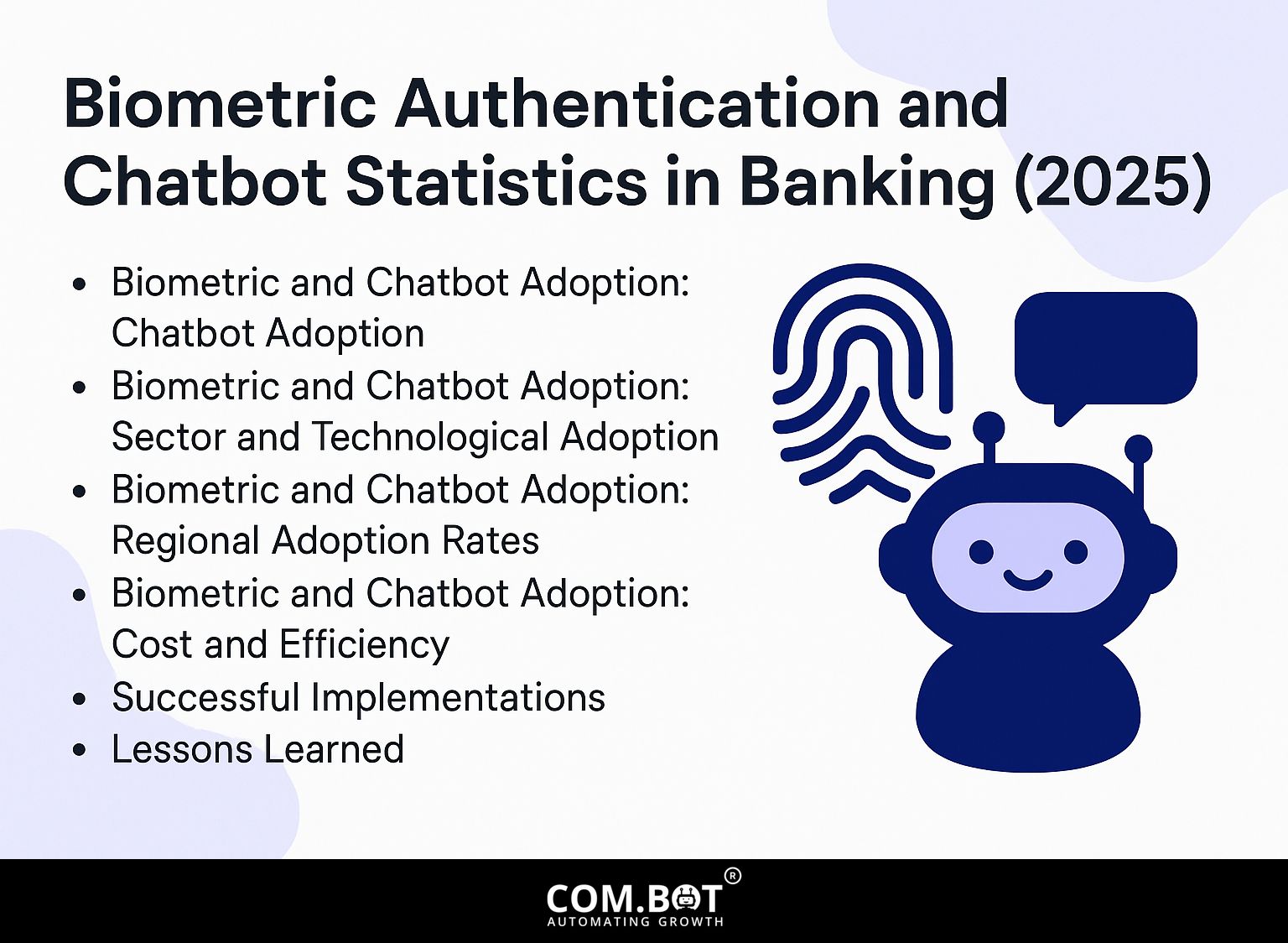
Biometric and Chatbot Adoption: Chatbot Adoption
Biometric and Chatbot Adoption: Sector and Technological Adoption
Biometric and Chatbot Adoption: Regional Adoption Rates
Biometric and Chatbot Adoption: Cost and Efficiency
The Biometric Authentication and Chatbot Statistics in Banking (2025) Data shows how chatbots and biometric technologies are being used in the banking sector. This data highlights trends in adoption, technological advances, regional differences, and cost efficiencies associated with these innovations.
Biometric and Chatbot Adoption data reveals that 73% of global banks are using chatbots, demonstrating their critical role in customer interaction. In the U.S., this number is even higher with 92% Banks are increasingly using chatbots that can understand voice commands, showing a clear move towards voice-controlled systems.
- Customer satisfaction with chatbots is high, at an impressive score of 84, translating to improved customer experiences and loyalty.
- 92% of banks have reported improved Net Promoter Scores (NPS) due to chatbot implementation, reinforcing their positive impact on customer perception and brand advocacy.
Sector and Technological Adoption shows that 98% of retail banks use AI chatbots, with 72% specifically utilizing them for customer onboarding, streamlining the initial customer interaction process. While only 21% use voice-enabled bots, this sector is ready to grow. AI chatbots with predictive features are employed by 54% of banks, showcasing advanced capabilities for anticipating customer needs and personalizing services.
Regional Adoption Rates highlight geographic differences: 85% of UK banks and 78% of German banks use chatbots, while Southeast Asia is at 62% This indicates different levels of change with digital technology in various areas.
Cost and Efficiency Information highlights the cost savings of using chatbots. The average interaction cost for chatbots is only $0.11, significantly cheaper than the $6 cost for live agent support. Banks have noted a 32% increase in customer service efficiency and a significant 61% reduction in call center wait times, underscoring cost savings and efficiency improvements.
Overall, this data shows how using chatbots in banking improves customer satisfaction, makes operations run smoother, and benefits the industry strategically. In the coming years, AI and biometric technologies will work together more closely, leading to more customized and effective banking experiences.
Successful Implementations
Many businesses have effectively used biometric authentication in their chatbots, resulting in happy users and solid security. Mastercard’s chatbot checks users’ identities with facial recognition, reducing fraud risk and increasing trust.
Similarly, eBay employs voice recognition within its chatbot, streamlining purchase processes and improving accessibility for visually impaired users. These changes have led to a 30% rise in user involvement and a clear increase in conversion rates.
By using technologies like Apple’s Face ID or Google’s Voice Match, these companies have made security better and provided a customized, easy experience for customers.
Lessons Learned
Looking at previous work can help companies avoid typical mistakes and improve connections later on. Important points from different case studies stress the need for teaching users and strong data protection steps.
For instance, one organization improved user engagement by introducing detailed onboarding sessions, resulting in a 30% reduction in support queries.
Using encryption methods for transferring data greatly increased user confidence, lowering cases of data leaks. Organizations should focus on regular checks of their security methods and talk to users about how their data is used. This helps build trust and encourages users to be involved and stay loyal.
Upcoming Developments in Biometric Security and Chatbots
Biometric authentication in chatbots is expected to grow, influenced by progress in artificial intelligence and changes in security practices.
Adding facial recognition helps improve user identification, allowing for smoother and safer interactions. Tools like Microsoft Azure Face API and Amazon Rekognition provide strong options for using this technology. Using predictive analytics can find security threats in advance, which builds user trust and improves interaction.
As AI technology progresses, chatbots may learn to recognize voice tones or emotions, potentially altering user interactions. Worth exploring: Secured Chatbots: Features and Use Cases. This integration will protect data and greatly improve the user experience.
Frequently Asked Questions
1. What is the importance of integrating biometric authentication with chatbots?
Integrating biometric authentication with chatbots adds an extra layer of security to the user experience, ensuring that only authorized individuals have access to sensitive information. It also improves the overall user experience by eliminating the need for remembering complex passwords.
2. What are the best practices for integrating biometric authentication with chatbots?
Some best practices for integrating biometric authentication with chatbots include ensuring compatibility with a variety of biometric technologies, providing clear instructions for users, and regularly updating the chatbot’s security protocols.
3. How can biometric authentication improve the efficiency of chatbots?
Biometric authentication eliminates the need for manual user verification, allowing chatbots to quickly and seamlessly authenticate users. This makes the chatbot work better and gives users a smoother experience.
4. Is biometric authentication secure for chatbots?
Biometric authentication is considered one of the most secure forms of authentication for chatbots. It uses specific physical features of people, making it very hard for unauthorized access.
5. What are the potential challenges of integrating biometric authentication with chatbots?
Some potential challenges of integrating biometric authentication with chatbots include the need for advanced technology, compatibility issues with older devices, and user concerns about privacy and data security.
6. How can businesses benefit from integrating biometric authentication with chatbots?
Integrating biometric authentication with chatbots can help businesses improve their customer experience, increase security, and reduce costs associated with manual user verification. It also helps businesses stay ahead of the competition by offering innovative and secure solutions.

